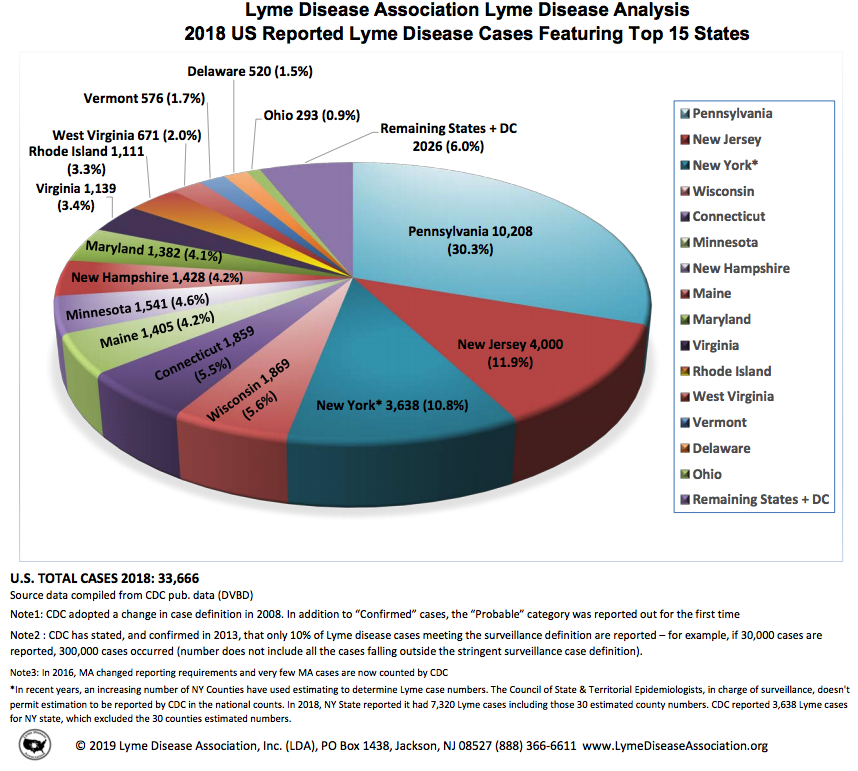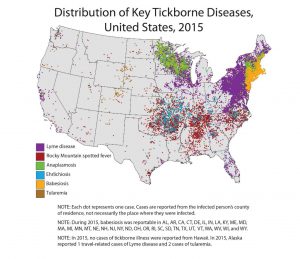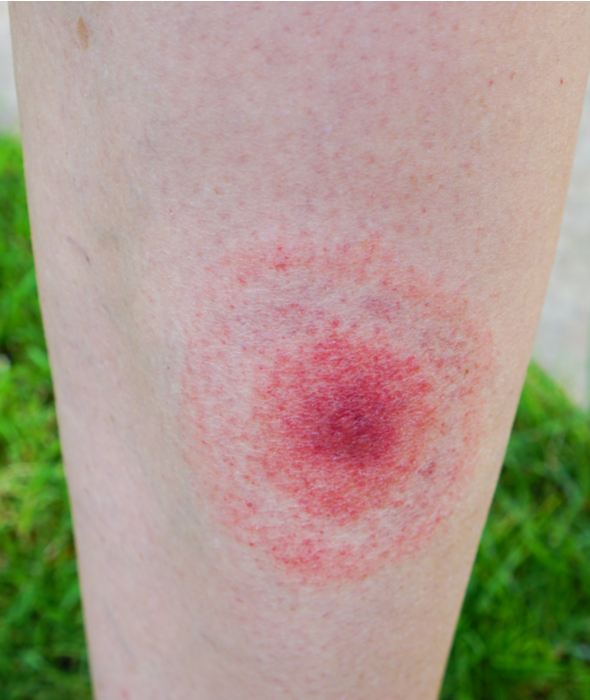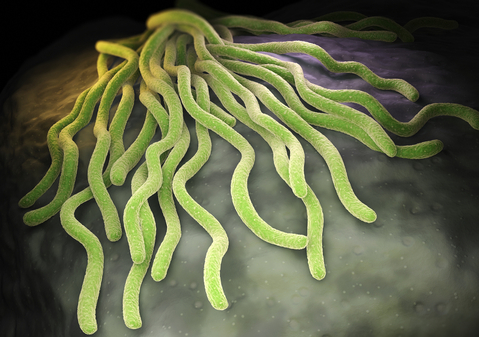lyme & Other Tick-borne diseases
Lyme Disease
Lyme disease was named in 1977 when a number of children in Lyme, Connecticut suffering from similar symptoms, came down with an unidentified illness later found to be transmitted by the black legged tick, better known as the deer tick. Lyme is the most common vector-borne disease in the United States, transmitted through the bite of an infected deer tick (Ixodes scapularis).
As the maps below indicate, Lyme and associated tick-borne illnesses are on the rise in the United States, particularly in the Northeast and Upper Midwest. You can track the trend of your own state on the CDC’s Reported Lyme Disease Cases by State, 2006-2016.


Precautions to prevent Lyme Disease
Even if you live in a state or county with a low incidence of Lyme, recognize the precautions necessary to avoid tick-borne illnesses:
- Identify and avoid tick habitat
- Understand the tick life cycle
- Modify your landscape
- Dress appropriately
- Use repellents
- Perform a daily tick check
- Promptly and properly identify and remove attached ticks
Other Tick-borne diseases
In addition to Lyme disease, Babesiosis, Ehrlichiosis, Anaplasmosis, Rocky Mountain Spotted Fever, Bartonella and other diseases can be transmitted from a single tick bite. Since immunity is not developed, you can contract these diseases again with new tick bites.

Many doctors are not familiar with co-infections, and few recognize the symptoms or screen for associated diseases. Blood tests vary in accuracy, reliability, and sensitivity.
Parasitic disease: Babesiosis is caused by a protozoan, Babesia microti. Symptoms include high fever, night sweats, chills, headaches, muscle pain, anemia or sleep disturbances. Treatment may consist of antibiotics as well as anti-malarial drugs.
Bacterial diseases: Ehrlichiosis & Anaplasmosis symptoms include high fever, chills, headaches, overall achiness. Treatment includes antibiotics. Rocky Mountain Spotted Fever symptoms include headaches and a characteristic rash that usually begins on wrists, palms, ankles, and soles of feet. Treatment includes antibiotics. Bartonella symptoms may include visual problems, headaches, rash, swollen glands, ongoing fatigue, mental symptoms. Antibiotics are used to treat Bartonella.
symptoms
Lyme disease is known as the Great Imitator. In fact, many Lyme patients are initially diagnosed with similar illnesses including but not limited to Fibromyalgia, MS, ALS, Chronic Fatigue Syndrome and other debilitating illnesses. The most definitive sign of Lyme disease is the erythema migrans (EM) bullseye rash. According to the Maine Centers for Disease Control, only half of Maine’s confirmed Lyme disease patients exhibited the EM rash. Other symptoms may include Bell’s Palsy, muscle and joint pain, cognitive defects, psychiatric symptoms, sleep disturbances, fatigue, flu-like symptoms, and a general sense of feeling poorly. Be especially aware that flu-like symptoms do not typically manifest in the summer when the incidence of Lyme is at its peak. If you develop unusual symptoms and live in a tick-endemic region, regardless of the season, consider the possibility of a tick-borne infection even if you don’t have the EM rash. Additional tick-borne pathogens including Babesiosis, Ehrlichiosis, and others may be transmitted by the same tick bite.
specific symptoms of Lyme disease
The physical and emotional impact of Lyme Disease is as diverse as the population it affects. While some with the illness will continue with a somewhat normal lifestyle, albeit while addressing a host of ongoing health issues, others are totally debilitated. Be aware that multiple symptoms, which may impact the brain, central nervous, cardiovascular, digestive, respiratory or musculoskeletal system may be migratory in nature, and sometimes change by the hour, day, week or month.
If you have a number of the symptoms listed below, they may indicate the presence of a tick-borne disease. While symptoms in of themselves do not constitute a diagnosis of Lyme or other tick-borne illnesses, serious consideration must be given by a physician to a tick-borne illness, especially to those living in a tick-endemic area.
Check out this interactive Lyme disease symptom checklist by Lymedisease.org

Symptoms Checklist
- A rash at the site of the bite or other parts of the body. The rash may or may not be the classic bullseye (EM) rash. It is important to note that fewer than 50% of patients recall the actual tick bite, and according to recent CDC numbers, fewer than 50% of confirmed cases in some states exhibit the bullseye rash.
- Twitching of facial or other muscles
- Facial paralysis (Bell’s Palsy)
- Stiff or painful neck
- Jaw pain or stiffness
- Double or blurry vision
- Increased floating spots
- Oversensitivity to light
- Decreased hearing in one or both ears
- Buzzing in the ears
- Pain in the ears, oversensitivity to sounds
- Ringing in one or both ears
- Diarrhea
- Constipation
- Upset stomach (nausea or pain)
- Bone pain, joint pain or swelling (may be migratory)
- Stiffness of joints, back, neck tennis elbow
- Muscle pain or cramps
- Night sweats or unexplained chills
- Heart palpitations or extra beats
- Endocarditis, heart blockage
- Tremors or unexplained shaking
- Burning or stabbing sensations in the body
- Fatigue, weakness, peripheral neuropathy or partial paralysis
- Numbness in body, tingling, pinpricks
- Poor balance, dizziness, difficulty walking
- Lightheadedness, wooziness
- Mood swings, irritability
- Unusual depression
- Disorientation
- Feeling as if you are losing your mind
- Over emotional reactions, crying easily
- Too much sleep, or insomnia
- Difficulty falling or staying asleep
- Narcolepsy, sleep apnea
- Panic attacks, anxiety
- Memory loss (short or long term)
- Confusion
- Difficulty with concentration or reading
- Going to the wrong place
- Speech difficulty (slurring or slow)
- Stammering speech
- Forgetting how to perform simple tasks
- Loss of sex drive
- Sexual disfunction
- Unexplained menstrual pain, irregularity
- Unexplained breast pain, discharge
- Testicular or pelvic pain
- Unexplained weight gain, loss
- Extreme fatigue
- Swollen glands/lymph nodes
- Unexplained fevers (high or low grade)
- Continual infections (sinus, kidney, eye, etc,)
- Symptoms seem to change, come and go
- Pain migrates (moves) to different body parts
- Early on, experienced a “flu-like” illness, after which you have not since felt well
- Low body temperature
- Allergies/chemical sensitivities
Note: While the above symptoms in of themselves do not constitute a diagnosis of Lyme and/or associated tick-borne illness, taken collectively, they may indicate the presence of an infection, particularly to those living in a tick-endemic environment with sudden and unexplained ailments. See your physician if you remove an embedded deer tick and/or suspect a tick-borne illness. If symptoms persist after multiple visits, consider a second or third opinion.
Diagnosis & Treatment Options
 There are two standards of care associated with the diagnosis and treatment of Lyme and associated tick-borne diseases, represented by the Infectious Disease Society of America (IDSA) & the International Lyme and Associated Diseases Society (ILADS). While both groups agree that the best chance of recovery is through early intervention, there are differences in their diagnosis and treatment protocols.
There are two standards of care associated with the diagnosis and treatment of Lyme and associated tick-borne diseases, represented by the Infectious Disease Society of America (IDSA) & the International Lyme and Associated Diseases Society (ILADS). While both groups agree that the best chance of recovery is through early intervention, there are differences in their diagnosis and treatment protocols.
Your physician should rely on her/his clinical judgment in diagnosing Lyme and associated diseases, even though you may not exhibit the classic EM rash. Such a diagnosis should be based on the time of year and outdoor exposure, history of tick activity in your area, specific symptoms and the ruling out of other diseases that might cause similar symptoms. Note that the reliability of blood tests for Lyme and co-infections remains controversial in determining the presence of an infection.
While the 2011 CDC Surveillance case definition of Lyme disease establishes uniform criteria for disease reporting, it should not be used as the sole criteria for establishing clinical diagnoses, determining the standard of care necessary for a particular patient, setting guidelines for quality assurance, or providing standards for reimbursement.
Link below for CDC Lyme Disease Treatment Options:

